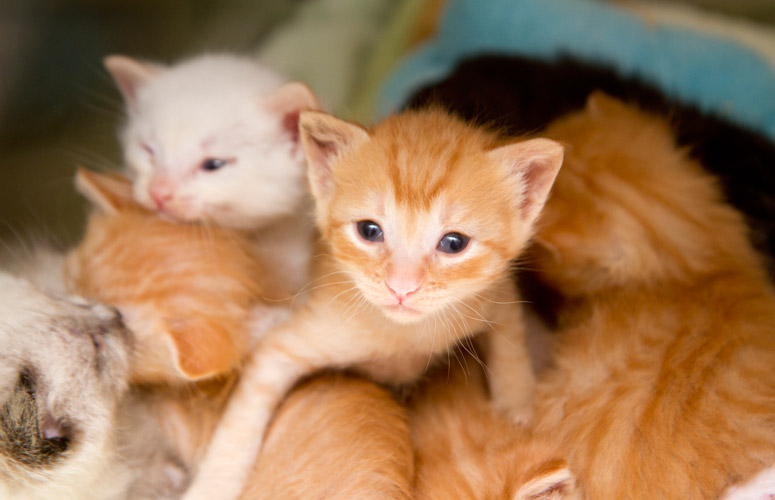
Kittens below the age of 8 weeks cannot consume anything else besides milk. It can be a difficult experience when you have a kitten whose mother is not around and you need it to feed. So how should you go about it?
Much like other mammalian animal offspring, kittens require milk within the first few weeks (usually 4) of their lives to grow and thrive. Their gastrointestinal tracts are not developed enough to digest any solid foods before this time elapses. For this reason, they exclusively depend on their mothers to obtain this milk through breast feeding.
Caring for a kitten is not largely an uphill task. They mostly require a warm and soft environment, along with regular feeding and getting rid of their litter. The mummy cat usually does the grooming, and also stimulates the kittens to urinate and defecate. This is because the kittens cannot be able to do it by themselves and, therefore, require some massaging action in the lower abdomen to facilitate it.
Having the mother cat around makes work for you easy, but what do you do when it’s just you? How should you go about feeding your kitten up until that point when it can have solid food?
Feeding your kitten – How should you go about it?
The first and most paramount thing you need to know is that you should never feed your cat cow milk. It has long been thought to be a universally acceptable milk substitute for many young animals when their mothers are not there. This is a dangerous assumption since it is not a guarantee that these young animals can be able to digest cow milk.
Before you start to feed your kitten, here is what to do.
Step 1 – Get a milk bottle for the kitten
Since kittens are born with the instinct to suckle, it will make your work a whole lot easier to get a feeding bottle. Ensure that it has a small nozzle since a kitten’s mouth is pretty small. The PetAg Nursing Kit is one of the best in the market for kittens.
You can also use a small syringe as an alternative to the bottle, but you may have to push the milk into the kitten’s mouth, taking care not to push in too much at a go to avoid choking. The Four Paws Pet Easy Feeder is an ideal one.
Step 2 – Get the right milk formula
Find your kitten a milk replacer that is specifically made for kittens. They are hard to find, but there are a few good brands such as the PetAg KMR – Kitten Milk Replacer.
It is formulated to resemble the milk of a mother cat, otherwise referred to as the queen. It provides the kitten with nutrients necessary for growth until it is 6 weeks old when you can begin to wean it.
When you have acquired these two items, you need to feed the cat. Here is how to go about feeding your kitten.
Step 3 – Reconstitute the milk
In the feeding bottle, add one part of the milk and two parts water. This means that you should use a 1:2 ratio. 1 tablespoon of the milk powder goes into 2 tablespoons of water. Ensure that you use warm water that is about 36 degrees Celsius. If you do not have a thermometer, make sure that the water feels like body temperature.
Step 4 – Feed the kitten
The amount of milk given is dictated by the weight of the kitten. For a kitten that weighs 4 ounces, 30ml of the liquid milk replacer is enough per feeding. For new born kittens, they need to feed every 3 to 4 hours.
If a kitten is weak, you can increase the frequency of feeding to every 2 hours. Older kittens that are above 4 weeks old can be fed every 8 hours. This is the most appropriate interval, and it ensures that your kitten maintains an ideal growth curve.
Dos and Donts of kitten feeding
Never feed your cat cold milk
This could lead to serious respiratory complications, especially if it is obtained from the fridge. Warm the milk to a temperature of 36 – 38 degrees Celsius.
Make sure the cat is properly positioned
Reclining your kitten’s head too far back could have fatal consequences. It could cause the milk to go down the respiratory tract which could result in pneumonia. Allow the kitten to feed as naturally as possible, preferably lying on its side as it would when breast feeding.
Rub your kitten’s belly after every feed
Kittens are unable to urinate and defecate on their own. For this reason, you have to massage their bellies gently to prompt these actions.
Do not change the formula often
Allow the kitten to get used to one type of formula as it grows. There may not be adverse effects from changing the milk, but it is safer to maintain one brand.
Do not introduce solids until 6 weeks are over
Keep in mind that your kitten is unable to digest solids before 6 weeks elapse. You may cause it untold digestive discomfort if you try to have it eat before time.
Ensure your kitten stays dry after feeding
Kittens are messy feeders, and they are bound to spill milk all over themselves. Make sure that they are dry before setting them down to keep them from losing their body heat .
Conclusion
A kitten, especially one under 6 weeks of age, should never go without milk. As a matter of fact, it should not be fed anything apart from milk replacer. Ensure that it is fed as often as its age, weight and health condition dictate. Take measures to keep them from choking and losing body heat during the feeding process. With the right attention and care, your kitten will grow in leaps and bounds and will be well on its way to weaning in a short time.


